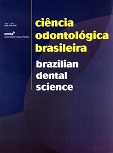Polyurethane and PTFE barriers for guided bone regeneration: A hismorfometric study in rabbits parietal bone
DOI:
https://doi.org/10.14295/bds.2008.v11i4.654Abstract
The purpose of this study was to evaluate the process of bone repair in surgical defects created in parietal bone of rabbits by the guided bone regeneration technique, using polyurethane (PUr) and PTFE barriers. The surface characteristics of the barriers in scanning electronic microscopic were also evaluated. In this research, 24 adult rabbits were used, 12 were in control group (C) and 12 were in experimental groups (right parietal – PUr group and left parietal – PTFE group). In the C group, the defect was filled only by blood clot. In the experimental groups, the PUr and PTFE barriers were positioned on the floor and on the surface of each bone defect. After 15, 30, 60 and 90 days, 3 animals in the C and 3 in the experimental groups were sacrificed and the defect bones were submitted to microscopic analysis. The results of the study showed no significant differences in the experimental groups, demonstrating quantitative and qualitative superiority bone fill and faster bone regeneration when compared to the C group. The physical barriers presented homogenous surface and no porosity. The PUr was biocompatible, osteoconductive and was not absorbed during the process of bone repair.
Downloads
Downloads
Published
How to Cite
Issue
Section
License
Brazilian Dental Science uses the Creative Commons (CC-BY 4.0) license, thus preserving the integrity of articles in an open access environment. The journal allows the author to retain publishing rights without restrictions.
=================




























